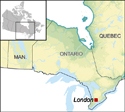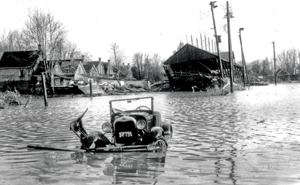London, Ontario’s, Climate Change Adaptation Strategy
.jpg)
Photo courtesy of Lotte Huxley
REDUCING FLOOD RISK THROUGH PROACTIVE DESIGN

Two tributaries of the Thames River meet in London, a city in southwestern Ontario with a population of 350 000. The Thames River has experienced several extreme floods since records began in 1791. Dikes and dams completed in the 1950s have since saved London from major flooding.

Photo courtesy of the University of Western Ontario Archives
London’s flooding history
The floods of 1883 caused extensive damage to homes and businesses and killed 17 people, prompting the City to construct protective dikes. The floods of 1937 were the most severe in the city’s history (see above image). River water rose 7 m, overflowing dikes and destroying 1100 homes and killing five people. After the 1937 and 1947 floods, the City constructed three dams along the Thames River to protect the community. Together, the dikes and dams have been effective defensive measures. Although the Thames River flooded its banks in 1977, 1986, 1997 and 2000, no water breached the dikes during these events.
In 2007, a University of Western Ontario (UWO) research team published a report that assessed the vulnerability of the Thames River watershed to changing climate. The study concluded that “climate change is expected to intensify flooding in the [river] basin, thus bringing flows in higher magnitude with more frequent occurrence.”
To act upon the study’s findings, the City engaged UWO researchers from the Department of Civil and Environmental Engineering to conduct a preliminary analysis of the city’s rainfall intensity, duration and frequency curves (IDF curves) in the context of a changing climate. These rainfall trends help define key design criteria for municipal water resource management infrastructure, such as storm sewers, overland drainage, street curbs, gutters, culverts, dikes and bridges.
Analysis of the IDF curves demonstrated that “rainfall intensity and frequency in the Thames River watershed had increased on the basis of historical observations (1965 to 2001) and is anticipated to continue to increase.” The research predicted that peak flow estimates for a small storm lasting fewer than 90 minutes would be increased by 10 to 15 percent, while peak flow estimates for a storm exceeding 90 minutes would be up to 30 percent greater than in the past.
For existing stormwater management systems, this would likely lead to more flooding and overflows. The report concluded that the City should consider developing significantly larger stormwater management facilities and drawing new flood lines within the Thames River watershed. The latter measure would potentially lead to changes in the City’s Official Plan and other environmental and water resource policies.
In response to the preliminary IDF curves analysis, the City’s Environmental and Engineering Services Department recommended the development of a comprehensive climate change adaptation strategy for London, with a focus on the impacts from flooding. This two-phase strategy, which was passed by City Council in December 2007, includes comprehensive engineering and scientific assessments to more clearly determine the risks to the level of municipal services that can be provided.
While still in its early stages, the adaptation strategy is progressing well. The City plans to move to Phase 2 following completion of the General Risk and Consequences Analysis in February 2011. In addition, based on a recommendation from a Blue Ribbon Panel tasked with reviewing London’s property development charges, the City has transferred responsibility for the construction of all stormwater management infrastructure from property developers to the City.
| Action | Completion date |
|---|---|
| Undertake detailed analysis and update of the city’s current IDF curves. | May 2010 |
| Investigate increasing the short-term capacity of the stormwater management system by 15 to 20 percent to account for climate change. | July 2010 |
| Engage experts to undertake a general risk and consequences analysis associated with impacts of storm events on the following city-owned and maintained infrastructure: buildings, floodways, streets, culverts, dikes, bridges and sewer design | February 2011 |
| Action | Completion date |
|---|---|
| Amend the City’s Stormwater Management Strategy and Subwatershed Study upon completion of the general risk assessment and updated IDF curves. | ~2013 |
| Consider developing a green infrastructure plan that incorporates an environmental/ecological approach to water resource management. | |
| Formalize a long-term Climate Change Adaptation Strategy for protection of municipal infrastructure and public and private property. |
Stoney Creek Restoration
This project demonstrates the City moving toward an ecological/systems approach to stormwater management, as stated in the long-term strategy (Phase II). In the spring of 2009, the City undertook channel restoration and remediation on a 1.8-km stretch of Stoney Creek. It also created an adjacent wetland, with a total drainage area of 3600 ha. One goal of the remediation was to ensure that the creek could support the stormwater runoff from a nearby 360-ha residential/commercial development. The remediation work is minimizing bank erosion and stormwater runoff volumes by restoring the creek's geomorphological and ecological functions.
This transfer of responsibility, which is unique among Ontario municipalities, allows the City to take an integrated systems approach to stormwater management. For example, when a new subdivision is constructed, the City, not the developer, will be responsible for designing and implementing stormwater infrastructure.
High-quality local climate data were a crucial component of this project. However, municipal officials note that relevant local-scale data (such as historical rainfall records) were incomplete and substantially lengthened the data gathering and analysis process undertaken in Phase I. Much of the City’s climate change strategy work would not have been possible without the City dedicating significant funds ($1.3 million was approved in 2008) to conduct research to examine the impacts of climate change on London’s infrastructure and to update the IDF curves.
London’s Adaptation Strategy demonstrates the importance of collaborative partnerships between climate change specialists and municipal staff. UWO’s rainfall projections will form the basis for revised engineering standards for the City’s stormwater management system. These changes will allow the City to make proactive incremental changes to its flood management program that should help avoid costly, disruptive and dangerous flooding in the future.
Contact:
Berta Krichker Manager of Stormwater, City of London Tel.: 519-661-2500, Ext. 4724 E-mail: bkrichker@london.ca
Page details
- Date modified: